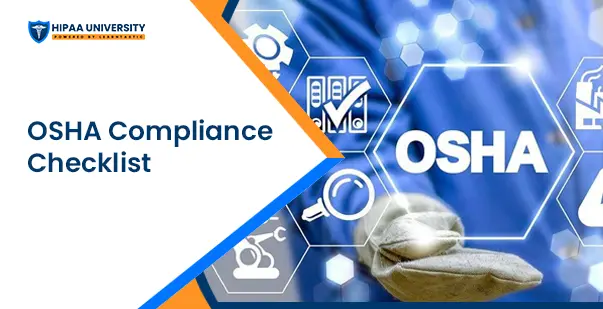OSHA Compliance Checklist

September 6, 2024
Table of content(s)
- Introduction
- What are OSHA requirements?
- OSHA compliance checklist
- Common OSHA violations and how to avoid them?
- How do you create and maintain your OSHA compliance checklist?
- Conclusion
Navigating the complex world of workplace safety can feel overwhelming, but it doesn’t have to. It is not enough to ensure that your business follows OSHA regulations. Instead, it is a major step in safeguarding your employees. That’s where an OSHA compliance checklist comes into play.
This checklist is an easy-to-understand guide comprising updated measures as required by OSHA. So are you managing a business or taking care of a large operation? An easy compliance checklist can make the necessary difference and create a safe work environment. Keep reading to understand the checklist and see if your business meets the OSHA standards or not.
What are OSHA requirements?
Understanding OSHA requirements is the first step in creating a safer workplace. OSHA ensures that workers are protected from workplace hazards. These regulations may seem complex but are intended to keep employees safe and secure.
OSHA aims to prevent injuries in the workplace and encourage a safer environment. It creates standards that are essential for employers to follow. These cover several safety aspects at the workplace. If the regulations seem challenging for you, do not worry. All you need to do is understand what applies to your industry and incorporate the relevant measures.
OSHA compliance checklist
Keep your workplace safe and secured by following the OSHA checklist. Here is a detailed checklist covering key areas you need to monitor and maintain regularly.
| Checklist | Description | Frequency |
| Hazard Communication | Ensure that all hazardous materials are properly labeled and that employees have access to Material Safety Data Sheets (MSDS) for all chemicals used. | Ongoing and as needed |
| Employee Training | Provide comprehensive safety training to all employees, covering both general workplace safety and specific hazards related to their job functions. | Initially and annually |
| Emergency Action Plan | Develop and communicate an emergency action plan that includes evacuation routes, assembly points, and emergency contact information. | Annually and updates |
| Personal Protective Equipment (PPE) | Ensure that the necessary PPE is available, in good condition, and that employees are trained on proper use. | Regular checks |
| Machine Guarding | Verify that all machines are properly guarded to prevent accidental contact with moving parts, ensuring employee safety during operation. | Regular inspections |
| Fire Safety | Maintain fire extinguishers, ensure clear access to exits, and conduct regular fire drills to prepare employees for emergency situations. | Monthly and annually |
| Recordkeeping | Keep accurate records of work-related injuries, illnesses, and safety inspections as required by OSHA. | Ongoing |
| Workplace Housekeeping | Regularly clean and organize workspaces to prevent slips, trips, and falls, and to ensure safe storage of materials. | Daily and weekly |
| Electrical Safety | Inspect electrical systems for frayed wires, improper grounding, and other hazards, and ensure that all electrical work is performed by qualified personnel. | Regular checks |
| Ergonomics | Assess workstations and tasks to reduce ergonomic risks, providing equipment and training to minimize strain and injury. | As needed and ongoing |
Read more: What Are the Consequences of a HIPAA Violation?
Common OSHA violations and how to avoid them?
Businesses can sometimes fall short of meeting OSHA standards. This causes common violations, resulting in hefty fines, and puts employees at risk. It is crucial to maintain a safe and compliant workplace. Here are a few common OSHA violations and explore tips to avoid them:
1. Inadequate Fall Protection
- Violation:Failing to provide proper fall protection for employees working at heights is one of the most cited OSHA violations.
- How to Avoid: Ensure that guardrails, safety nets, and personal fall arrest systems are in place where required. Regularly inspect and maintain these systems to guarantee they are in working condition.
2. Lack of Hazard Communication
- Violation: Not properly labeling hazardous chemicals or failing to provide employees with access to Safety Data Sheets (SDS) can lead to serious safety issues.
- How to Avoid: Clearly label all hazardous substances and make sure SDS are readily available and updated. Train employees on how to handle these materials safely.
3. Insufficient machine guarding
- Violation:Exposed moving parts, which can lead to severe injuries, are a common issue in workplaces with machinery.
- How to Avoid: Install proper guards on all machinery and conduct regular inspections to ensure they remain secure and effective. Educate employees on the dangers of bypassing or tampering with guards.
4. Inadequate respiratory protection
- Violation: Not providing the necessary respiratory protection in environments with harmful dust, fumes, or chemicals can endanger workers’ health.
- How to Avoid: Perform a hazard assessment to determine the need for respiratory protection. Provide appropriate masks or respirators, and ensure employees are trained on their correct use and maintenance.
5. Failure to Control Hazardous Energy (Lockout/Tagout)
- Violation: Failing to properly lockout/tagout machinery during maintenance can result in accidental startups, leading to injuries or fatalities.
- How to Avoid: Implement a comprehensive lockout/tagout program, train employees on the procedures, and regularly audit the system to ensure compliance.
6. Electrical Hazards
- Violation: Unsafe electrical practices, such as using faulty wiring or failing to ground electrical equipment, are frequently cited.
- How to Avoid: Conduct regular inspections of electrical systems, repair any issues immediately, and ensure that only qualified personnel handle electrical work.
Read more: Most Common HIPAA Violations You Should Avoid
How do you create and maintain your OSHA compliance checklist?
It is essential to create and maintain an OSHA compliance checklist for ensuring your workplace meets safety standards and protects your employees. A well-organized checklist equips you to stay updated with safety measures. This makes it easier to identify and address potential hazards. Here are a few steps to help you create and maintain an effective OSHA safety checklist.
- Identify applicable OSHA standards:
- Research the OSHA standards that apply to your industry and specific workplace environment. This ensures your checklist covers all necessary safety regulations.
- Conduct a workplace safety audit:
- Perform a thorough inspection of your facility to identify potential hazards and areas that require compliance with OSHA regulations.
- List required safety measures:
- Based on the audit, compile a list of safety measures and practices that need to be implemented or maintained to meet OSHA standards.
- Prioritize critical areas:
- Prioritize high-risk areas and tasks in your checklist, ensuring that the most critical safety measures are addressed first.
- Assign responsibilities:
- Assign specific tasks and checklist items to appropriate personnel, ensuring accountability for each aspect of OSHA compliance.
- Schedule regular reviews:
- Set a schedule for regular reviews and updates of the checklist to ensure ongoing compliance and to address any new safety concerns.
- Provide employee training:
- Ensure all employees are trained on the checklist procedures and understand their role in maintaining a safe workplace.
- Document compliance efforts:
- Keep detailed records of inspections, training sessions, and any corrective actions taken as part of your compliance efforts.
- Stay updated on OSHA changes:
- Regularly check for updates to OSHA regulations and adjust your checklist accordingly to stay compliant with any new requirements.
- Conduct periodic re-audits:
- Periodically re-audit your workplace to ensure ongoing compliance and to identify any new risks that may have emerged.
Conclusion
An OSHA compliance checklist makes sure that your business is compliant with the safety standards set by OSHA. This keeps your employees and your business safe from mishaps. This OSHA required training checklist acquaints yourself with OSHA requirements and fixes problems when they arise, making the workplace safer for everyone. Thus, the checklist supports the company not only in the prevention of accidents and injuries but also in penalties and legal issues.
Safety is not created once and for all, but it is a continuous process, and the presence of an accurate and always updated compliance checklist is a fundamental tool. This way, you show the responsibility of employees’ lives and potential future in an organization as well as your company’s care about it.





